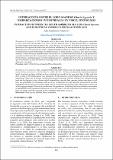Por favor, use este identificador para citar o enlazar este ítem:
https://hdl.handle.net/20.500.12958/3594| Título : | Interacción entre el lobo marino Otaria byronia y embarcaciones industriales en Pisco, otoño 2013 |
| Otros títulos : | Interaction between the South American sea lion Otaria byronia and industrial vessels in Pisco (autumn 2013) |
| Autor : | Rivadeneyra-Villafuerte, Sofia |
| Palabras clave : | Otaria byronia;pesquería;Pisco;interacción |
| Fecha de publicación : | jul-2021 |
| Editorial : | INSTITUTO DEL MAR DEL PERÚ |
| Citación : | Rivadeneyra-Villafuerte S. 2021. Interacción entre el lobo marino Otaria byronia y embarcaciones industriales en Pisco, otoño 2013. Bol Inst Mar Perú. 36(1): 282-303 |
| Citación : | Boletín IMARPE 36(1), 2021; |
| Resumen : | Durante mayo y junio del año 2013 se estudiaron las interacciones entre lobos marinos y los lances de pesca de anchoveta de la flota industrial en Pisco. Se obtuvieron 104 registros de lances con presencia de individuos y la interacción fue de tipo operacional. Se determinó una correlación inversa entre la cantidad de lobos marinos por lance y la distancia a las colonias, evidenciándose menor probabilidad de interferencia de los lobos marinos, cuando la flota operó más lejos. Además, la clase etaria que presentó mayor interacción con esta flota fueron los machos, lo que podría estar asociado con el término de la temporada de reproducción y con las estrategias de forrajeo. La interacción entre el lobo chusco y la flota pesquera no estuvo relacionada con la cantidad de individuos de la población, sino que se incrementó cuando las embarcaciones ingresaron a las áreas donde los lobos marinos se reproducen, alimentan y forrajean. ABSTRACT: In Pisco, we studied the interactions between South American sea lions and the anchoveta fishing hauls made by the large-scale fleet in May and June 2013. A total of 104 fishing hauls were recorded with the presence of individuals and the interaction was operational. There was an inverse correlation between the number of South American sea lions per fishing haul and the distance to the colonies, which showed that when the fleet operates further from them, it will have less probability of interference with sea lions. Furthermore, the age class that presented the greatest interaction with this fleet were males, which may be associated with the end of the reproductive season and with foraging strategies. The interaction between this species and the fishing fleet is not related to the number of individuals in the population, but increases when the vessels enter the areas where the sea lions reproduce, feed, and forage since they depend on the availability of the same resources. |
| URI : | https://hdl.handle.net/20.500.12958/3594 |
| ISSN : | 04587766 |
| Aparece en las colecciones: | Boletín 36(1), 2021 |
Ficheros en este ítem:
| Fichero | Descripción | Tamaño | Formato | |
|---|---|---|---|---|
| Boletin 36-1 articulo16.pdf | 3,46 MB | Adobe PDF |  Visualizar/Abrir |
Este ítem está sujeto a una licencia Creative Commons Licencia Creative Commons

